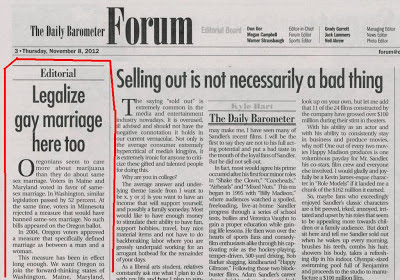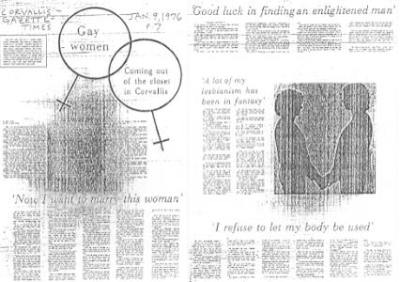PHOTO: (click to enlarge) a political cartoon about the death of newspapers. Similar to the above political cartoonist, I was also a Minneapolis Star evening newspaper boy and therefore amused to see his caption that reminisces, 'When I was a kid, I carried the . . . Minneapolis Star.' (Cartoon by Jack Ohman the Oregonian editorial cartoonist in "Paper Trails. . .," Oregonian, Mar. 22, 2009, p. E2. See JackOhman.com and my previous posts Minneapolis Star newspaper boy Jack Ohman (3/24/09), Newspaper TV guides R.I.P. (9/25/10), Corvallis newspaper circulation (10/15/08) and Kim Kraemer auto mechanic 1980 (11/7/09))
Here is my letter to the editor commenting on the future of local newspaper reporting:
While collecting money each week from my older customers, in my first real job as a 12 year-old newspaper delivery boy, I recall them fretting that new-fangled TV technology would cause the demise of local newspapers. At that time, even small cities had multiple competing newspapers with morning and afternoon editions.
Indeed, the advent of TV led to the demise of evening newspapers, including the G-T, which to stay in business had to become a morning paper and convert from molten metal letterpress to computer typeset offset printing technology.
Today, older newspaper customers similarly fret new-fangled internet technology will cause the demise of local news reporting, both in print and online. One example was the discussion at a Corvallis City Club meeting led by the recently "retired" editor of the Albany Democrat-Herald, Hasso Hering. (See Nov. 13 article in the Democrat-Herald, "Panel looks at future of local media" or Gazette-Times, "Tomorrow's news today.")
Having spent decades managing and investing in high-tech businesses that literally go obsolete every few years, I am sympathetic to the plight of newspaper publishers.
Decades ago, a beleaguered publisher of the G-T blamed the disappearance of newspaper boys on the "lesser work ethic of the younger generation." On the contrary, I believe today's boys and girls, who would have probably delivered newspapers in the 20th Century, will invent a way to provide local news reporting for a profit in the 21st Century.
(Quoted from Thomas Kraemer, "Kids still have initiative," Gazette-Times and Democrat-Herald, Nov. 25, 2012, p. C4)
See these links:
- Bennett Hall, "Tomorrow's news today, City Club panel looks at future of local media" gazettetimes.com posted Nov. 13, 2012
- Bennett Hall, "Panel looks at future of local media," democratherald.com posted Nov. 13, 2012
- "Farewell, hh, D-H Editor Hasso Hering reflects on his long career in newspaper journalism" democratherald.com posted April 26, 2012
- hh-today.com Hasso Hering started after being laid off as editor of the Democrat-Herald by the paper's parent company, Lee Enterprises
- corvallisadvocate.com The Corvallis Advocate -- a recently started local newspaper
- www.christonium.com/corvallistidbits/Corvallis Tidbits - another online source of local news reporting
- UPDATE: Jan. 17, 2013 - Staff, "Longtime G-T pressman rolls into retirement," Gazette-Times, posted Jan. 17, 2013 -- he is 66 years old and started working at G-T in 1965 and got to see the shut down in 1970 of the old letterpress printing operation downtown to the offset printing plant in Corvallis until 1998 when the printing operation moved to Albany.





